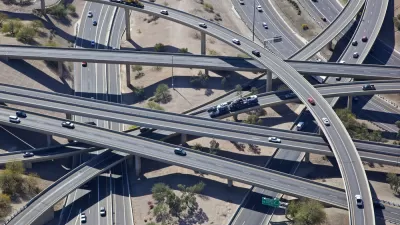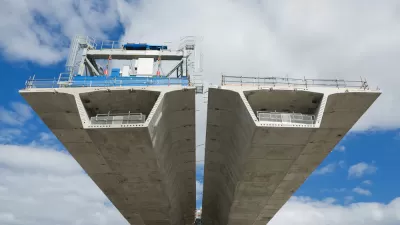A new analysis form the Pew Charitable Trusts showed a 20 percent reduction in state spending on transportation between 2002 and 2011, compared to a 4 percent drop from the federal government over the same period.
As written in Governing by Daniel Vock, a recent analysis on transportation funding throughout the last decade by the Pew Charitable Trusts illuminated the shifts in federal and state spending. While federal funding usually receives the brunt of criticism as an unreliable partner for funding, in fact, states are also to blame in their drop of transportation spending over the last decade.
As the report discusses, between 2007 and 2011, "average annual spending on highway and transit nationwide was $207 billion. Of that total, $82 billion, or 40 percent, came from states; $74 billion, or 36 percent, from localities; and $51 billion, or 25 percent, from the federal government."
According to the Vock, the federal government's average spending figures "are higher in part because it was still spending some $13 billion in stimulus money on transportation in 2011. Without the money from the recovery package, federal spending would have dropped by 25 percent between 2002 and 2011. The biggest reason for the spending drop at both levels was a decrease in buying power from fuel taxes."
The federal government relies on this fuel tax for maintaining and funding most of the country's transportation infrastructure, but expenditures have been outpacing revenues for the last decade. As Vock writes, "states are only in a slightly better position. They rely on vehicle taxes for a fifth of their road funding, but those revenues, too, have been falling. Pew suggested that declining vehicle ownership may be one reason those taxes dropped by $8 billion, or 21 percent, in the decade leading up to 2012."
Coupled with the decline in fuel tax revenues, "the cost of road construction increased by 60 percent between 2002 and 2012, meaning the dollars states and the federal government collected did not stretch as far."
FULL STORY: States Are Actually Driving Transportation Funding Declines

Planetizen Federal Action Tracker
A weekly monitor of how Trump’s orders and actions are impacting planners and planning in America.

Map: Where Senate Republicans Want to Sell Your Public Lands
For public land advocates, the Senate Republicans’ proposal to sell millions of acres of public land in the West is “the biggest fight of their careers.”

Restaurant Patios Were a Pandemic Win — Why Were They so Hard to Keep?
Social distancing requirements and changes in travel patterns prompted cities to pilot new uses for street and sidewalk space. Then it got complicated.

Platform Pilsner: Vancouver Transit Agency Releases... a Beer?
TransLink will receive a portion of every sale of the four-pack.

Toronto Weighs Cheaper Transit, Parking Hikes for Major Events
Special event rates would take effect during large festivals, sports games and concerts to ‘discourage driving, manage congestion and free up space for transit.”

Berlin to Consider Car-Free Zone Larger Than Manhattan
The area bound by the 22-mile Ringbahn would still allow 12 uses of a private automobile per year per person, and several other exemptions.
Urban Design for Planners 1: Software Tools
This six-course series explores essential urban design concepts using open source software and equips planners with the tools they need to participate fully in the urban design process.
Planning for Universal Design
Learn the tools for implementing Universal Design in planning regulations.
Heyer Gruel & Associates PA
JM Goldson LLC
Custer County Colorado
City of Camden Redevelopment Agency
City of Astoria
Transportation Research & Education Center (TREC) at Portland State University
Camden Redevelopment Agency
City of Claremont
Municipality of Princeton (NJ)




























